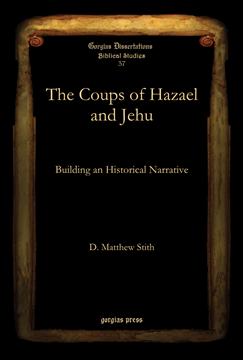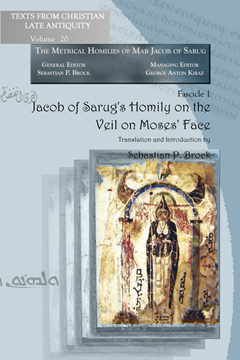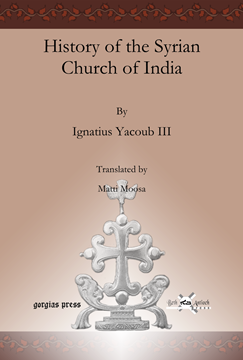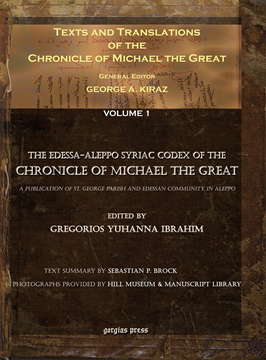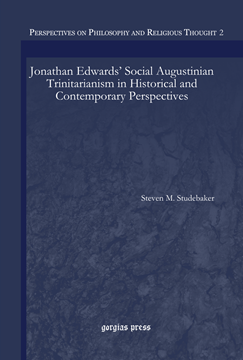The Coups of Hazael and Jehu
Building an Historical Narrative
Series: Gorgias Biblical Studies 37
ISBN: 978-1-59333-833-6
The Coups of Hazael and Jehu offers a narrative reconstruction of the events surrounding the rise of Hazael to the throne of Aram-Damascus and Jehu to the throne of Israel in the mid-eighth century. These near-simultaneous dynastic changes were parts of a major shift in the political, military, and economic structure of the Levant, which took place as the mighty armies of Assyria pushed into the region. The book argues that Jehu’s bloody overthrow of Joram and Hazael’s irregular seizure of power after the death of his predecessor were not independent events, but responses to the Assyrian threat.
$132.00 (USD) $79.20 (USD)
Jacob of Sarug’s Homily on the Veil on Moses’ Face
Metrical Homilies of Mar Jacob of Sarug
Translation and Introduction by Sebastian P. Brock
Series: Texts from Christian Late Antiquity 20
ISBN: 978-1-59333-644-8
This edition of Mar Jacob of Sarug's (d. 521) homily on the Veil of Moses asks what the veil means. Jacob finds the hermeneutical key in Paul’s exegesis of Gen. 2:24 – that the man and the woman becoming one symbolizes Christ and the Church. The bride must wear a veil until such time as her bridegroom comes to remove it at their marriage ceremony. The volume constitutes a fascicle of The Metrical Homilies of Mar Jacob of Sarug, which, when complete, will contain the original Syriac text of Jacob's surviving sermons, fully vocalized, alongside an annotated English translation.
$34.00 (USD) $20.40 (USD)
History of the Syrian Church of India
By Ignatius Yacoub III; Translated by Matti Moosa
ISBN: 978-1-59333-982-1
This book covers the history of the Syrian church of India from its founding by the apostle Thomas in 52 A.D., until the first half of the 20th century. During which, the author explains the various obstacles the Indian Church faced in therms of theology and colonialism. The several delegations of the Apostolic See of Antioch to India from the 17th to the 20th centuries form an indispensable account of the vicissitudes of a struggling native Indian Church trying to preserve its Antiochene identity.
$166.00 (USD) $99.60 (USD)
The Edessa-Aleppo Syriac Codex of the Chronicle of Michael the Great
Edited by Gregorios Yohanna Ibrahim; Contribution by Sebastian P. Brock & Hidemi Takahashi; Foreword by George Anton Kiraz
ISBN: 978-1-59333-147-4
The invaluable Chronicle of Michael the Great makes the scholarly resources on this unique manuscript available together for the first time. Now inaccessible, the Chronicle is the largest medieval chronicle known, and is available here for the first time in history as a facsimile copy of the original manuscript. The Chronicle is one of the most important primary sources on the history of the Middle East, especially the period between the rise of Islam and the Crusades.
$292.00 (USD)
Jonathan Edwards’ Social Augustinian Trinitarianism in Historical and Contemporary Perspectives
ISBN: 978-1-59333-846-6
The Trinity played a significant role in Jonathan Edwards’ theology. But what was the nature of his trinitarian theology? A common view among Edwards scholars is that he embraced the dialectical psychological and social models of the Trinity. This study suggests that Edwards consistently used one model of the Trinity—the Augustinian mutual love model. Edwards uses the mutual love model to portray the loving relationships among the divine persons and in doing so stands in continuity with other early-Enlightenment apologists for traditional trinitarianism.
$191.00 (USD) $114.60 (USD)
The Nestorian Monument of Hsî-an Fû in Shen-Hsî, China
By James Legge
Series: Analecta Gorgiana 70
ISBN: 978-1-59333-886-2
The “Nestorian Monument” or “Nestorian Stele” is a fascinating attestation of the work of Syriac-speaking missionaries in sixth-century China. Commemorating the diffusion of Christianity in China from 635-781, the inscription was erected in the latter year as a public monument. The inscription in Chinese, supplemented with some Syriac, provides a brief outline of Christian doctrine and provides an account of how Christianity came to China. This book offers an English translation of the monument along with the original language text.
$47.00 (USD) $28.20 (USD)
